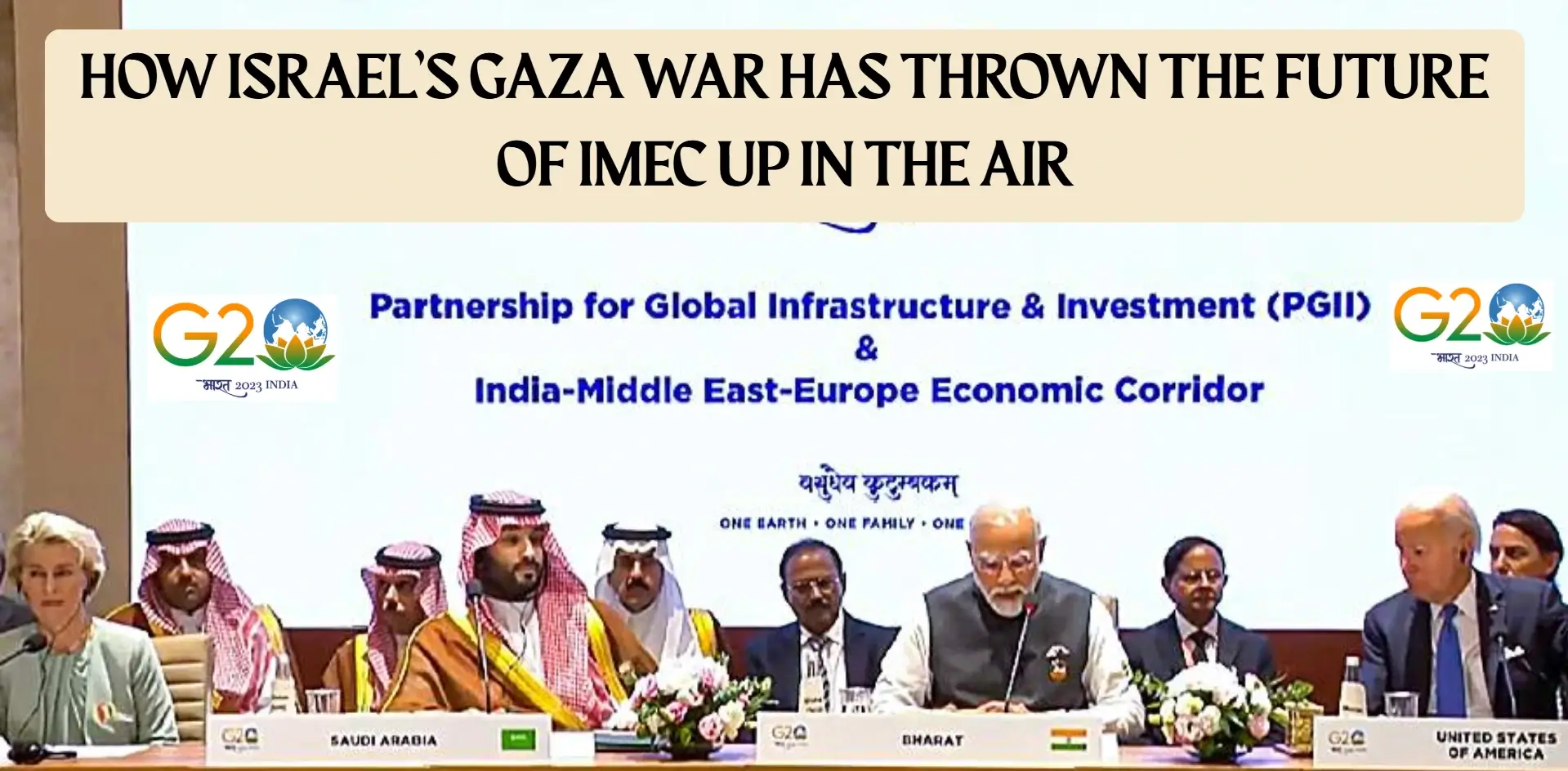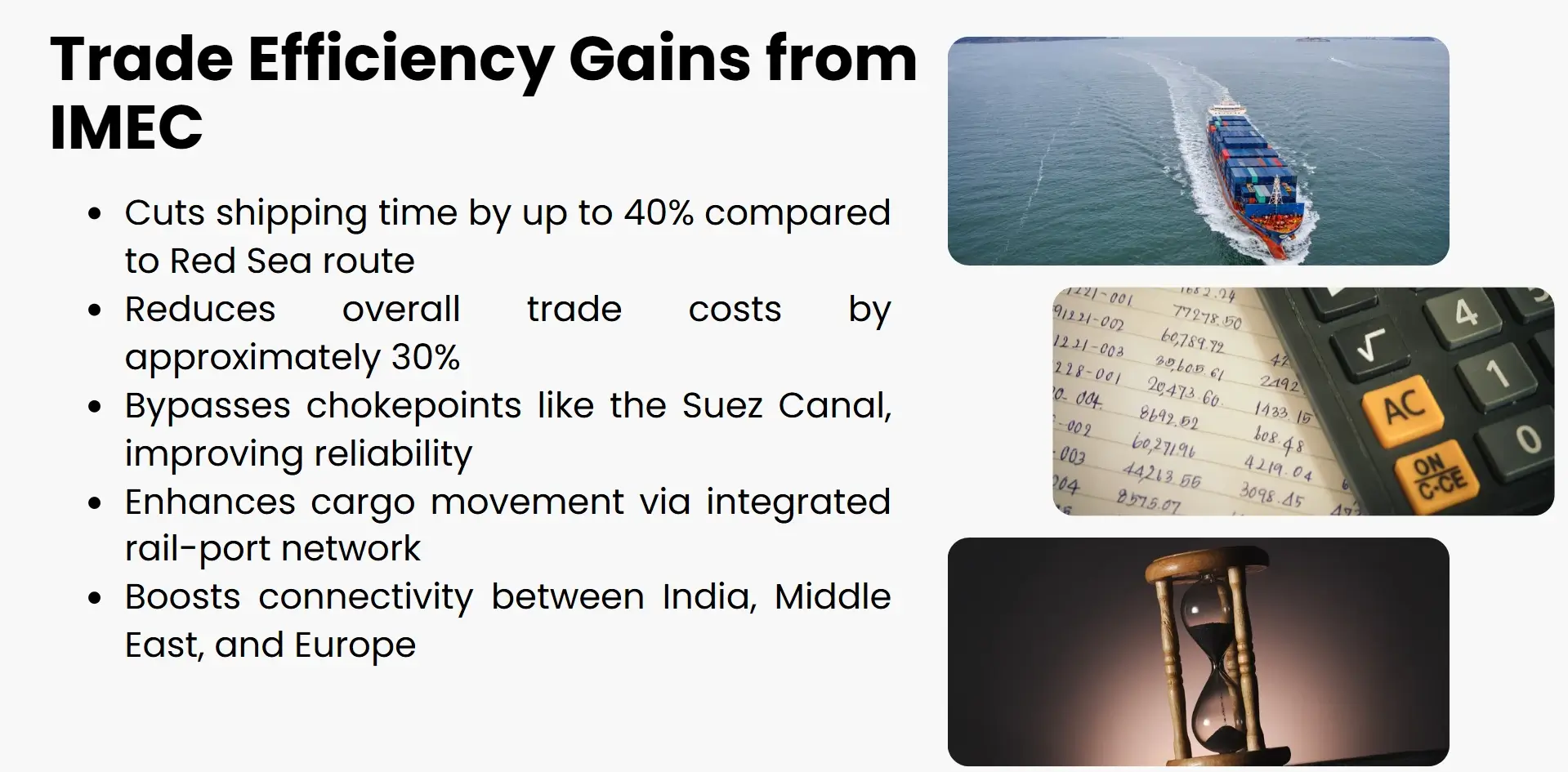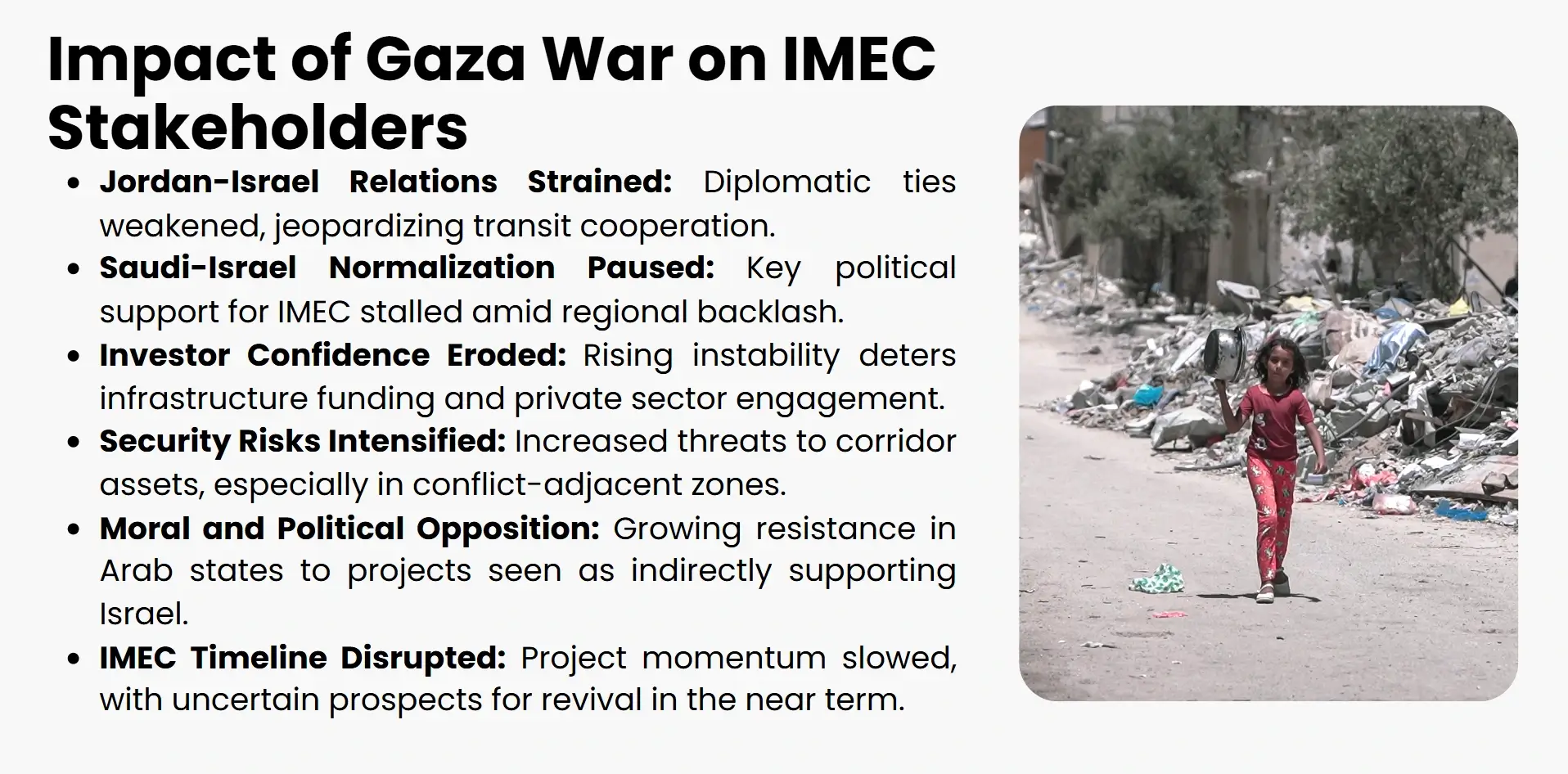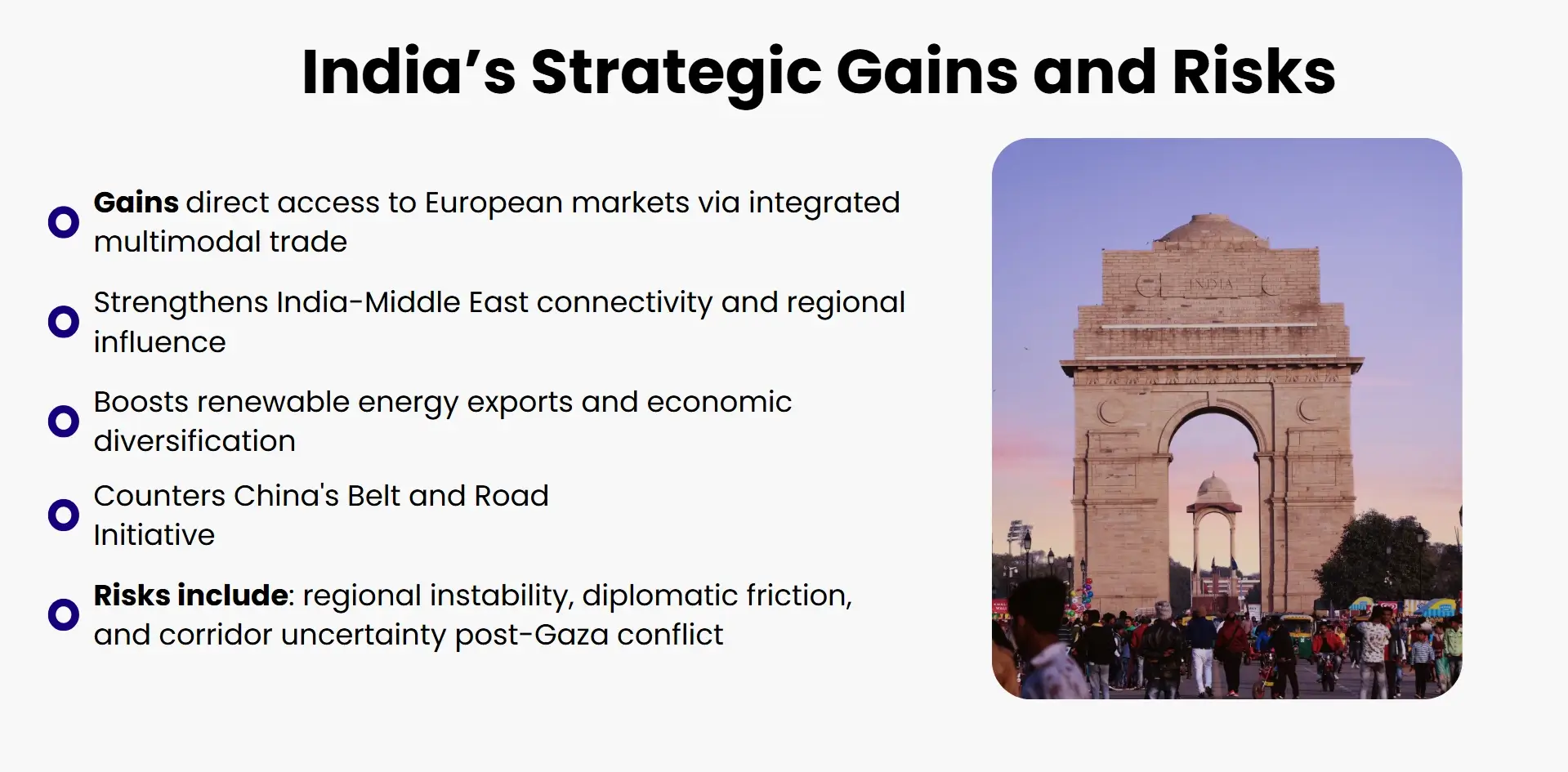The article is a highlight of the economic impact of war in mid-east because the Gaza war has thrown the IMEC momentum out of gear, just demonstrating how conflicts in the region have the ability to disrupt the world infrastructure and trade aspirations.

At the G20 conference in New Delhi in 2023, this economic route debuted, heralded as the new pathway that would change global trade and patterns. Planned to connect Indian western ports with Europe through the UAE, Saudi Arabia, Jordan, and Israel, IMEC was expected to minimize the shipping time by almost 40%, decrease the costs, and provide a sustainable alternative to Chinese initiatives. It brought together the symbolism of uncommon repose in geopolitical alignment between usually separated powers, with economic collaboration seemingly having won out over local confrontation.The future of IMEC has been however thrown into uncertainty by the outbreak of war in Gaza by Israel. The nature of this conflict has not only caused a humanitarian crisis but it has also broken diplomatic relations between stakeholders in the corridors. The idea of regular relations with Israel has been rejected by Arab nations, and the region's increasing instability has made planning and infrastructure investment more difficult. The great vision of connectivity previously used to be perceived as a bold vision; however, the political, strategic, and even moral challenges of connectivity are challenged essentially.This article discusses how Gaza war has derailed the flight plan of IMEC not only in the context of its initial promise but also due to the role of regional conflict and strategic readjustments of interests of India. It claims that although IMEC is a mighty concept, it can only be sustained with peaceful relation and trust as well as renewed multilateral interaction.
The vision and Architecture of IMEC
The IMEC was created as a visionary initiative to transform the transportation and the intercontinental trade corridors. It is designed to show economic desire and recalibration of geopolitics.
Origins Strategic Intent
IMEC was launched publicly at the G20 Summit in New Delhi in September 2023 and was supported by India, the United States, the European Union, the United Arab Emirates, Saudi Arabia, and Israel. The corridor was also projected as a balancing force to the Belt and Road Initiative (BRI) by China,which the US considered as a regulation-free and framework that is opaque and unsustainable to international trade. It was meant to study economic integration to enhance a more enhanced integration in Asia, the Middle East and Europe, and strengthen strategic partnerships between democracies and emerging powers.

Way of the Route and the Corridor Design
IMEC has two main parts: the eastern corridor and the north corridor. The eastern leg links the western ports in India, including Mundra and Nhava Sheva to the UAE through maritime routes. Then cargo would be transported by rail throughout Saudi Arabia and Jordan all the way to the Israeli port of Haifa. The northern leg is then connected to Haifa to European ports via Piraeus in Greece and further to Italy and EU points using the existing rail connection.This multimodal supply chain (sea, rail, and digital system) would eliminate about 40 percent of shipment time and nearly 30 percent of logistics cost, at the same time avoiding overcrowded chokepoints such as the Suez Canal.
Infrastructure and Innovation Elements
Other than physical transportation, it was also seen as an innovation corridor, IMEC. It encompasses clean hydrogen pipeline plans, electricity grids and high-speed Internet cables. These elements also represent an international vision to instigate a green energy transition and digital connectivity among countries involved. The corridor is also meant to facilitate smart logistics hubs, harmonization of customs and integrated supply chains.This infrastructure would not only help trade but also encourage regional industrialdevelopment, employment, and transfer of technology to some of the regions which have been poorly connected in the past.
Economic and geopolitical interests
The scale of the economies linked by IMEC has a total GDP above 47 trillion, and thus, has tremendous potential when diversifying trade and strategic independence. In the case of India, it provides direct access to Europe, avoiding the maritime weaknesses. To Gulf countries, it strengthens their position of being logistical and energy centres. In the case of the EU and US, it unites a stronger relationship with the emerging markets and weakens that of Chinese infrastructure.Essentially, IMEC was not only a trade corridor but a template of a new world of cooperative globalization.
Gaza War and its disruptive effects
The Gaza war has broken that entirebase, making logistical barriers geopolitical obstacles.

Violation and Humanitarian Disaster Catalyst
The crisis started with the war in Gaza. The humanitarian toll is immense with more than 61,000 reported deaths and general collapse of the infrastructure. The economy of Gaza has completely crumbled and a famine-like situation has developed, especially among the children and mobile families. Such a humanitarian disaster has been condemned globally and further sparked questions about the military operations of Israel.The war spreading to Lebanon, Syria and the Red Sea belt has also destabilized West Asia, making civilian infrastructure to be high risk areas and increasing insurance premium on trade corridor.
Failure of Diplomatic Momentum
IMEC depended on a one-off thaw between the Arabs and Israelis. Saudi Arabia was almost normalizing with Israel and Jordan had sworn to collaborate regionally. War has however, occasioned a reversalof these advances. The relations between Jordan and Israel are currently at an all-timelow due to proposals to absorb internally displaced Palestinians. Saudi Arabia has been making its position increasingly strong, insisting on concessions by Israel over Palestinian statehood that Israel is not amenable to. The western branch of the corridor- Haifa to Europe via Jordan is no longer politically viable.
Investor Confidence and Fragmentation of Strategies
The war has brought about a confidence crisisamong investors and logistics planners. The picture of risk assessments has taken a radical turn with the port of Haifabeing considered to be under threat of Hezbollah missile attacks. Insurers of international trade have elevated premiums, and shipping operators are changing routes by coming up with longer, more expensive routes.In the meantime, other regional players such as Turkey and Iran are proceeding with the alternative paths at the expense of the paralysis of IMEC. China is also a beneficiary of the delay because itsBelt and Road Initiative does not have a lot of competition in the region.
Technological Challenges and Existential Threats
Prior to the war, IMEC had addressed with manageable problems- harmonization of tariffs, lack of development of rail connections and regulatory vacuums. Nowadays,diplomatic isolation, security threats and moral objections to the warlike attitude of Israel aggravate these difficulties. It is not engineering solutions but peace-building and political reconciliation that will determine the future of the corridor now.The vision of IMEC is still compelling, although its achievement is no longer about infrastructure, it is about stability in the region and will in the world.
From Manageable to fundamental Challenges
The technical challenges that the IMEC faced were minor, and thus could be overcome. The Gaza war, however, has morphed these into geopolitical and strategic areas of deep rooted concern that pose the feasibility of the corridor itself.
Pre-War Problems
After it was announced in India, the major problems were technical and logistical. It did not provide a system of a single tariff, financial integration had a low level among partners, and there was an asymmetry of port capacities. The insurance was spotty along the route and even the grandiose cross-Saudi/UAE railway needed to connect the sea legs lagged in development.Although these problems have a critical impact, it was believed that they could be handled through coordinated investment, stakeholder meetings and phased implementations. As a matter of fact, partners were already to think of a meeting within sixty days to seal an action plan. The economic rationale did not evaporate too readily in the corridor and could be lifted by the political process of a Middle Eastern stability at last.
Post-War Realities
This optimism was overturned by the onset of war in Gaza just a few weeks after. The western leg of the corridor used to be Jordan-Israel relations but they have sharply deteriorated. Saudi Arabia has taken a tougher position and conditioned normalization on serious compromises on the Palestine statehood- something Israel is not ready to offer.This has increased the level of security risks in the war when it expanded to Lebanon, Syria and the red sea. The main mode of the network, Haifa port, is regarded as at missile attack risk and therefore, the western leg of the corridor becomes politically and commercially unsustainable.
Change in nature of challenges
The modality questions of rail gaps, customs harmonization, and digital integration have now become life and death questions. The corridor can also be only as successful as infrastructure, but also trust, diplomacy and peace in the region. The Gaza war has fractured the alliances themselves that made IMEC possible and has transformed their likely blueprint into what is being termed at this point as a day-after project until conflict is resolved.Even Indian strategic partners in the Gulf are repositioning themselves in fear of being perceived to be a part of a corridor with Israel with continuous violence. Re-establishing political accord with the future of the IMEC is now becomes a major factor, in addition to mere track and cable lying.
Strategic Calculus of India

The interest of India in the India-Middle East-Europe Economic Corridor (IMEC) is motivated by economic vision as well as geopolitical vision.
- India, as an anchor at the eastern end of the corridor would have direct access to the European markets, at a reduced time with a shipping time reduction of close to forty percent.
- Since India already gets the maximum trading partner status in the European Union, IMEC should be seen as a strategic improvement of the current level of trading activities with the area, particularly manufacturing, pharmaceuticals, and digital services.
- There is more than commerce at stake: IMEC fits into the greater ambition of India to diversify its supply chain and energy sources. The infrastructure available in the corridor, such as clean pipelines of hydrogen, electricity lines, and high-speed data cables, would facilitate India in dominating green energy exports and positioning itself as one of the digital leaders. In such a way, such initiatives as the Blue Raman cable connecting Mumbai with Genoa increase the position of India as a center of data and technology.
- Geopolitically, IMEC helps India wield its relationship with theWest, Gulf countries, and Israel, as well as respond to the Belt and Road Initiative by China. But the Gaza war has made this equation tricky.
- India has to now negotiate a polarised Middle East, strategic neutrality, and to keep its corridors viable without losing the key partners. IMEC continues to form the backbone of Indian plans to have a $30 trillion economy by 2047, however, it will succeed based on finesse and not through strength or influence.
Global Implications and Strategic Options
The derailment in the Gaza war of IMEC has gone very far in the world, having transformed the modern global infrastructure diplomacy.
- To the United States and the European Union, IMEC was positioned as a strategic response to the Chinese Belt and Road Initiative (BRI), and provided an open, multilateral, model of connectivity.
- Its stall has left the Beijing with breathing space to extend its influence on Africa, the Gulf and Central Asia, although Iranian stall added fuel to strengthen the supremacy of the China-Pakistan economic corridor (CPEC).
- The dilemma is very difficult as to how Europe should balance this energy shortage and trade desires with the divided Middle East. The EU aims at importing green hydrogen products in the Gulf countries and digital connections through under-sea cables are also threatened.
- In the meantime, the U.S. has to reconcile its Indo-Pacific policy with new interest in West Asia, even as the Trump-era politics make tariff regimes and multilateralism harder to manage.
- New strategies are emanating. Turkey and Egypt can present alternative routes and India can look at strengthening its ties with Southeast Asia and Africa. And none are as big or as symbolic as that of IMEC.
- Whether it can come out of this limbo depends on the regional peace and a re-alignment of diplomatic process, one which is flexible enough to allow economic pragmatism as also political realities.
Conclusion
IMEC became a daring design of global economic reconstruction to redefine trade, energy, and digital connectivity. It was an infrastructure and diplomatic triumph of strategic planning since it had the ability to shorten the shipping time, supply chain specialization, and cooperation within the region. But the weaknesses of such ambitions are displayed on unsteady geopolitical ground as Gaza war.Failure in diplomatic relations, externally instigated security risks as well as the turn and twist of alliances have made IMEC seem a far-fetched dream. Although India and its associates are undeterred concerning its vision, peace-building, restoration of trust and a readjusted regional order is what matters now to the future of the corridor. IMEC is not at end but it is near to suspense. It will need more than engineering; it needs political boldness, as well as multilateral involvement and commitment to stability.